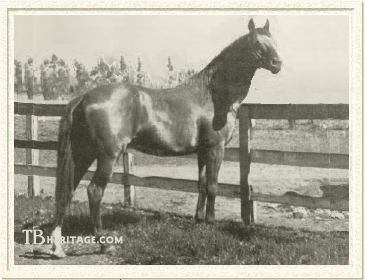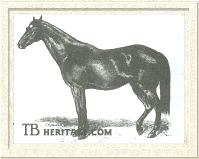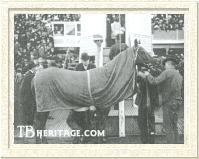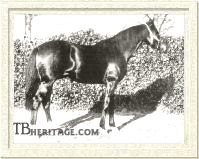|
|
Emperor of Norfolk

|
|
 |
|
|
Emperor of Norfolk was born in 1885, bred by Theodore Winters at his second stud farm in Northern California, Rancho del Rio, then located just south of Sacramento along the banks of the Sacramento River. His sire was Winters' pride and joy, the undefeated Lexington son, Norfolk, who was the state's premier sire and had a significant impact on thoroughbred breeding in the latter quarter of the nineteenth century. |

The great Marian
| |
His dam was one of America's stellar broodmares, Marian, a mare by Malcolm who had trekked across the country from Illinois in the ownership of turf editor and journalist Joseph Cairns Simpson. Winters acquired Marian from Simpson, and for him she produced ten foals to the cover of Norfolk at Winter's Yolo County California Rancho del Arroyo, and later at his Sacramento farm, Rancho del Rio. Almost all were top racehorses; those that ran mostly in California, such as Duke of Norfolk and Duchess of Norfolk, beat everything in the state.
|
The Norfolk-Marion colt Czar was unbeaten in California, but died of shipping fever enroute to his eastern engagements; King of Norfolk was a fast juvenile who made his mark in the east; their younger brother, El Rio Rey, was the country's top juvenile, unbeaten in all his starts in Chicago, New York, and elsewhere. Of all his talented siblings, Emperor of Norfolk was the best on the turf, and later proved to be the best sire son of his great sire. After Norfolk was retired from stud, Marian went on to produce another star in Yo Tambien, her filly by Joe Hooker, who was celebrated as the "Queen of the Turf" in America in the 1890s.
Regarded as the best California-bred horse until Swaps began his career in the 1950s, Emperor of Norfolk was purchased as a yearling by E.J. "Lucky" Baldwin and sent to Baldwin's southern California farm, Rancho Santa Anita. He was heavily campaigned in races across the country. As a juvenile, he was the dominant two year old in the U.S., winning 12 of his 18 starts, including the Kenwood Sweepstakes at Washington Park (Chicago), Coney Island's Autumn Stakes, and the Citizens' Stakes at Kansas City.
At age three he ran against the best horses in the country, winning nine of his eleven starts. He took the Troubador and Lawyers' Stakes at Nashville, Jerome Park's (New York) Handicap Sweepstakes and the Spuyten-Tuyvel Stakes; Coney Island's Swift Stakes. He also won two of the most important races of his era, the Brooklyn Derby and Washington Park's American Derby over 1-1/4 miles for three year olds, in the latter beating Belmont Stakes winner Sir Dixon. Following the latter race, He won the Drexel Stakes and the Sheridan Stakes at Washington Park. He broke down during an exercise run at Washington Park, during which he slashed two seconds off the then-record for a mile, covering the distance in 1:38. His tendons ruined and his turf career over, he was shipped back to Rancho Santa Anita to begin his career at stud, having won 21 of his 29 races, and placed in six others, at distances between five and twelve furlongs. His total earnings for his two seasons was $79,290, an enormous sum at the time. |

Cruzados in 1903

Americus (Rey del Carreres)
| |
Retired to stud at Baldwin's Rancho Santa Anita in California, he sired many stakes winners, including Cruzados, a sprinter who excelled at 7 furlongs, and whose progeny today represent the surviving sire line of Lexington.
But the son with the most influence on the breed today was Americus, who ran in the U.S. with the name Rey del Caredas, until corrected to his intended name Rey del Carreres, the fastest horse of his day, whose most spectacular win was the six-furlong Culver Handicap carrying 135 pounds. Sold by Baldwin to Richard Croker for $40,000.00, Rey del Carreres was exported to Great Britain, where, under the name Americus, he won a number of stakes races. Through the Americus daughter, Americus Girl, he was a progenitor of the "flying filly" Mumtaz Mahal, and thus *Mahmoud, *Nasrullah, Royal Charger, and Tudor Minstrel, and the many other greats who have come since. Horse of the Year and Eclipse Award winner for 1989, Sunday Silence, had multiple lines back to Emperor of Norfolk, three through Mumtaz Mahal and one through the mare Pretty Jo (1948, by Bull Lea) to El Salado, a daughter of Emperor of Norfolk.
|
Emperor of Norfolk was a big bay horse, deep in the girth and with powerful hindquarters; his speed, versatility, weight-carrying abilities and heart earned him the sobriquet "California Wonder." He lived to the age of 22, dying on December 15, 1907, the day after Baldwin opened his Santa Anita race track. When the word spread that "the Emperor" was dying, "racing men who are at the Santa Anita track gathered in numbers at the Baldwin stable and the grand old horse passed away like a king, surrounded by his court."
He was buried on the ranch, at the palm-lined entrace to Baldwin's racing stables, under a huge Maltese cross, the symbol on Baldwin's racing silks, and was later joined there by Baldwin's three other American Derby winners. The cross and remains of the California Wonder and his companions were later transferred to the paddock garden of the modern Santa Anita racetrack facility, where his distant descendants still run.
--Patricia Erigero |
|
|
|

